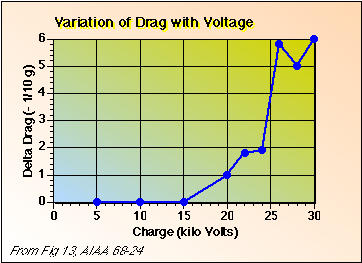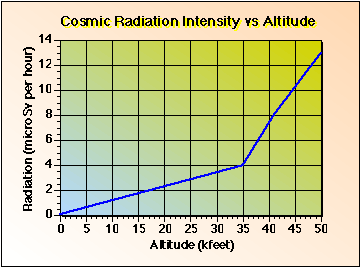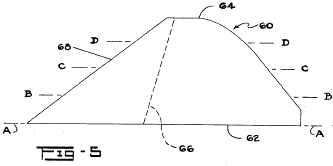|
 45
years since Concorde first flew, a successor does not
yet exist. In the intervening years, research and progress
to developing a viable civil supersonic aircraft has
stagnated. 45
years since Concorde first flew, a successor does not
yet exist. In the intervening years, research and progress
to developing a viable civil supersonic aircraft has
stagnated.
Although
there is again a recent upsurge in activity on developing
a civil supersonic aircraft, a Supersonic Business Jet,
all of the designs in the public domain have serious
drawbacks.
Key
Problems
There
are three barriers to viable supersonic flight:
- Sonic
Boom
- Wave
Drag
- Cosmic Radiation
Protection
The
first problem is well known and acknowledged; the second
one is related to the first; the third one has yet to
be widely acknowledged, mainly because the first stumbling
block has yet to be overcome.
Sonic
Boom
It
is now accepted that a next generation supersonic aircraft
must be able to fly supersonically overland. This
means it must at the very least produce an almost unnoticeable
sonic boom. Ideally, it would not produce any
boom at all.
Our
1999 study into the Market Potential for a Supersonic
Business Jet (SSBJ) identified that the overwhelming
majority of users would not pay a premium for an aircraft
with a relatively small cabin, restricted airfield performance
and high operating cost whose superior speed they could
only use over the sea. Business aircraft require
flexibility or their utility value is severely diminished.
Wave
Drag
While
the Sonic Boom is an operational problem, the Wave Drag
associated with supersonic flight is the most intractable
and serious performance problem.
50%
or more of the total drag on a supersonic aircraft is
due to wave drag - the drag created by the sonic shock
wave.
The
current approaches to sonic boom minimisation do not
seek to eliminate the shock wave, but to shape or flatten
the rise time of the N wave signature at ground level
so that it is less objectionable.
Many
of the current approaches to boom reduction actually
increase the drag on the aircraft and so reduce range
and payload.
This
is clearly not an ideal solution.
The
best solution is to eliminate the shock wave and to
prevent it from forming in the first place, so that
we eliminate both the sonic boom and its associated
wave drag.
There
are a number of approaches to achieving this and information
on one system has been in the public domain since 1968.
This approach is called Electroaerodynamics.
Electroaerodynamic Sonic Boom Elimination
It
is already known that shock waves can be eliminated
by applying an electrostatic charge to the leading edge
of an airfoil. Experiments carried out by Northrop
Norair in the late 1960s on a model airfoil immersed
in silicone oil, showed that the intensity of the shock
wave could be reduced or the shock wave eliminated altogether.
The drag on the airfoil was also reduced, the drag reduction
increasing exponentailly with applied voltage.

This
shows that maximum drag reduction of 0.6g was obtained
at ~26kV and again at 30kV.
Tests
were further carried out in a supersonic windtunnel
of 1.5 by 3 inch test section using Schlieren photography.
In
one test at Mach 1.5, an 8 degree double wedge airfoil
model 1.5 inches in span and 0.375 inches in chord was
used. When a charge of 70kV at 0.01milliamperes
was applied to the leading edge, the shock wave disappeared.
The power used was 0.7 watts.
For
a 20 metre span straight wing, this would equate to
less than 400W of electrical power.
The
step changes in drag seen in the graph above above support
a quantum energy level or wave harmonic interpretation
of the wave drag reduction mechanism.
Cosmic
Radiation
The
danger posed by cosmic radiation to future high altitude
supersonic operations has not been adequately recognised.
The
EPA sets a maximum radiation exposure guideline of 5mSv
per year. The FAA recommended maximum is 20mSv
over 5 years - i.e. a mean of 4mSv per year. Ground
level radiation in the USA averages .06µSv per
hour or 0.5mSv per year. At 35,000 feet altitude
this increases to 4µSv per hour and at 41,000
feet in polar latitudes, the rate rises to 8µSv
per hour, or over 100 times ground level radiation in
the USA.
British
Airways' data for 1994 shows that Concorde crews with
a 12 month average duty tme of 382 hours received a
dose of 4 to 6 mSv, or 10 times the normal background
dose of living at ground level. If we say the
mean dose was 5mSv in 382 hours from a year flying Concorde,
this equates to 13µSv per hour - 200 times the
ground level exposure.
A
typical chest X ray delivers 0.02 to 0.05mSv.
This means that flying as a member of a Concorde crew
is the equivalent of receiving 100 chest X Rays per
year or 2 chest X rays every week.
Put
in these terms, it is evident that potential exposure
to cosmic radiation for future supersonic aircraft crews
would be very significant, when compared to what human
beings have naturally evolved to live with.
Concorde
normally cruises at about 50,000 feet. It has
been known to descend during flights to reduce the radiation
exposure during active solar events. If a large
number of future SSBJs were routinely forced to fly
below FL500, this would start to bring them into conflict
with subsonic traffic.
Concorde
crews were therefore already receiving the EPA and FAA
maximum recommended annual ionising radiation dose from
operations at FL500. SSBJ design studies are proposing
flight at even higher altitudes up to FL700.
According
to Dr John Gofman, eminent nuclear physicist and a long
term researcher in the field of the biological effects
of radiation, 75% of cancer may be caused by the excessive
use of X Rays by the medical profession.
It
is possible that the only reason there have not been
widespread cancer problems with Concorde crews is the
very limited nature of Concorde operations since 1976
and the rotation of crews through the fleet.
This
would be very different with a large SSBJ or SST fleet,
particularly for the cabin crews who work longer duty
hours per year than flight crew.
An
effective light-weight protection system must be found
to protect high altitude SST and SSBJ operations from
these high levels of ionising radiation.

Comparison
of SSBJ Designs
Gulfstream QSJ
Gulfstream
have presented some preliminary sketches of their "QSJ"
(Quiet Supersonic Jet) design.
Gulfstream
recently patented a boom reduction accessory.
One way to reduce the boom is to lengthen the aircraft.
This leads to a long and narrow aircraft which is not
practical. Gulfstream therefore propose to use
a telescopic boom on the front of their SSBJ to increase
the effective length of the aircraft during supersonic
flight and so reduce the boom.
This
is a fairly obvious idea and not particularly difficult
to conceive. It is similar in concept to the variable
pitch spike device patented by John Morgenstern (US
5,740,984) of Lockheed in the late 1990s.
In
order to improve field performance and reduce approach
speed without the need for a Concorde type droop nose
and high angle of attack approach, Gulfstream have also
proposed to use a swing wing, like some military aircraft.
This
type of system has never been used on a civil aircraft
and would add complexity, weight and cost.
A
better system would be to use flap blowing or Circulation
Control Wing technology as used on the TSR2 supersonic
bomber and ground attack aircraft. The aircraft
carrier based Buccaneer used a similar less advanced
system.
The
TSR2 weighed about 90,000lbs, so it is in the same weight
category as an SSBJ. It had a wingspan of only
37 feet to reduce gust sensitivity during low level
supersonic flight. This constraint would not exist
for an SSBJ so a wider wingspan and larger wing area
would be used. The TSR2 used flap blowing to reduce
the approach speed to only 130 knots - which is in the
same order as most subsonic commercial transports today.
Cross feed was used to maintain flap blowing in the
event of an engine failure on approach.
With
a 1400 square feet wing area for a 90,000lb SSBJ instead
of the 700 square feet of the TSR2, flap blowng could
potentially reduce approach speed to well under 100
knots. The complex mechanics and weight of swing
wing would be replaced with fixed pneumatics giving
much higher field performance. Any possible higher
fuel consumption for the approach and landing phase
would be more than offset by the improved field performance
which is a vital factor for the flexible use and utility
of business aircraft.
Aerion/
Reno ASSET
The
Reno Aeronautical ASSET design of Richard Tracy, now
incorporated into Aerion, is based on achieving natural
laminar flow over the entire wing chord to reduce drag
during supersonic flight.
The
basic wing cofiguration was originally very similar
to the Douglas X3 experimental aircaft or the Lockheed
F-104 Starfighter.
The
latest version of the wing planform now uses rounded
wing tips.
This
planform is very similar to the Kline Fogleman supersonic
wing disclosed in US Patents 3,706,430 and 4,046,338.
 From US 3,706,430. From US 3,706,430.
This
wing design has an interesting underside modification
that it is claimed allows it to reach a 30 to
40 degree angle of attack before stalling. The
modification is a spanwise step, similar in concept
to a leading edge cuff or a Coanda type step.
It increases underside air pressure and hence
lift. (We do not know if Aerion intend to incorporate
this feature on their design).
However,
if the Aerion design is not capable of unrestricted
overland supersonic flight, it will not achieve
market acceptability.
Supersonic
Aircraft International (SAI)
SAI's
concept was designed for them by Lockheed Martin.
It is intended to be a low boom design capable of overland supersonic flight.
The principles are to be found
in PCT WO 01/58754 and WO 02/46038.
The
first patent covers Lockheed's "slotted edge" concept
to reduce the high drag normally associated with the
blunt leading edge (ABLE) approach to boom reduction.
Lockheed claim this will reduce the drag associated
with normal blunt edges by 40%.
The
second patent is for the complete aircraft design that
we see presented by SAI. This incorporates the
underfuselage "whale snout" which Northrop Grumman used
to successfully reduce the boom signature of a modified
F5 in August 2003. Lockheed filed their patent
application in December 2001. The Lockheed design may also incorporate a gull wing. This use
of an outer anhedral section is also similar to the
TSR2, to increase lateral stability.
However,
the most arresting characteristic of this design is
its weight. With a MTOW of 65,000 kg to 69,000
kg, i.e. in the region of 150,000lbs, the design is
50% or more heavier than conventional SSBJ designs without
boom reduction.
According
to Flght International's report (12-18 October 2004,
P34), a 2003 study by Raytheon found that a 6 passenger
small SSBJ would weigh 46,000kg and be 41m long for
a conventional version or 54,000 kg and 50.4m long for
a low boom version.
This
is paradoxical and in our opinion shows that these current
approaches to boom reduction are not going to be workable.
It is a similar situation to the so called "low boom
- high drag" paradox of using blunted leading surfaces
to reduce boom.
The
sonic boom overpressure of an aircraft is proportional
to its weight. The boom is inversely proportional
to the length of the aircraft raised to the power 3/2.
Therefore in the Raytheon study, although the low boom
design weighed more than the conventional one, its length
was increased to more than compensate and so reduce
the boom to a low level.
The
Lockheed Martin/SAI design is even more strange in that
it has the same length as the Aerion and Gulfstream
concepts (40 metres) but its empty weight is nearly
twice as much. The tail braced wing, with an area
75% greater than the Aerion or Dassault designs, cannot
account for all of this weight increase.
This
is either being reported incorrectly or an extremely
inefficient approach is being taken to minimise the
boom. The doubling in weight of the Lockheed Martin
design will double the boom pressure, all other things
being equal. The Skunk Worlks concept is therefore
extremely inefficient if it has to double the inherent
boom with boom reduction measures that then have to
compensate for their own weight as well as the basic
aircraft.
This
is simply unworkable, inelegant and shows a brute force
approach to the problem.
Cessna
Cessna
apparently have an SSBJ design based on the cabin of
the Citation X. With current technology, the difficulties
involved in achieving useful performance diminish exponentially
- and vice versa - as cabin size decreases. However,
at 34,000 kg (75,000 lbs) MTOW it is still a large aircraft.
Sukhoi S21
The
Sukhoi S21 design was orignally intended to be developed
with Gulfstream in the early 1990s. It bears a
resemblance to the advanced Sukhoi fighter designs but
is not optimised for boom reduction. Without a
western partner, the aircraft would have no chance of
success in the North American market.
Dassault
The
Dassault design has not been publicly promoted since
2000 and officially Dassault are engaged in further
research as part of the European Union HISAC program.
Its main drawback is its inability to fly supersonic
overland.
Conclusion
The table below summarises the specifications that
have been published on the various SSBJ concepts.
|
Aerion
|
Gulfstream
|
SAI
|
Dassault
|
Length
|
44.2m
|
42.7m
|
40.4m
|
32.4m
|
Span
|
19.8m
|
18.3m
|
19.2m
|
16.95m
|
WingArea
|
130m2
|
|
230m2
|
130m2
|
EmptyWeight
|
20,475kg
|
|
36,230kg
|
17,000kg
|
MTOW
|
40,860kg
|
45,500kg
|
69,460kg
|
39,000kg
|
MFW
|
|
|
|
20,800kg
|
Thrust
|
36,000lb
|
|
66,000lb
|
40,000lb (est.)
|
It
is our opinion that all of these designs have serious
shortcomings. If the current approach to boom
reduction is so counter productive, in greatly increasing
the weight of the aircraft, it becomes effectively impractical
and too expensive.
It
is clear that current aeronautical science does not
know how to solve the supersonic problem. At each
stage, the constraints militate against it. The
boom and wave drag create enormous drag - so range is
limited and large amounts of fuel have to be carried.
This increases weight, compromising range again and
increasing the boom. The aircraft is lengthened
to reduce the boom or other complex features added -
which seem to be producing inordinate weight increases
in their own right and are therefore counter productive.
The
question of Cosmic Radiation protection has not even
begun to be publicly addressed.
We
believe that a completely different approach is required,
using the Wave Modelling approach and the Electrostatic Theory of Aerodynamics
to design a vehicle not for boom reduction but to prevent
the boom from forming in the first place. The
real solution we need to work towards is to completely
eliminate the boom and wave drag - without adding weight.
Then we can produce a reasonably sized vehicle with
realistically acceptable characteristics and performance.
Selected
References
1.
The Market
Potential for the Supersonic Business Jet, Market
Study, 1999, Meridian International Research.
2.
Sonic Boom Minimisation Revisited, R Seebass, AIAA
98-2956
3.
"Living with Radiation", D. Carlisle, Business &
Commercial Aviation, September 2001.
4.
"Recent Experiments in Supersonic Regime with Electrostatic
Charges", MS Cahn, GM Andrew, WE Anderson, Northrop
Corp, AIAA 70-759.
5.
"Electroaerodynamics in Supersonic Flow", MS Cahn, GM
Andrew, Northrop Corp, AIAA 68-24.
6.
"Northop Studying Sonic Boom Remedy", Aviation Week
and Space Technology, 22/1/68, P21
7.
"Experiments Indicate Electric Charge Could Quiet Sonic
Boom", Product Engineering Magazine, 11/3/68 P35-36.
8.
"Method and Apparatus for Reducing Shock Waves and Aerodynamic
Drag", US Patent 3,446,464, WA Donald, 1969.
9.
"Ion Doping Apparatus and Method for Aerodynamic Flow
Control", US 6,247,671, Accurate Automation Corp, 2001.
|
